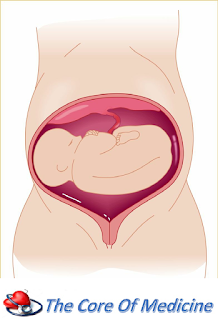Orientation of the long axis of the fetus to the long axis of the uterus. The most common lie is longitudinal (99% of fetuses at term).
Longitudinal: fetus and mother in same vertical axis
Transverse: fetus at right angle to mother
Oblique: fetus at 45° angle to mother
Presentation:
Portion of the fetus overlying the pelvic inlet. The most common presentation is cephalic (96% of fetuses at term).
- Cephalic: head presents first
- Breech: feet or buttocks present first. The major risk of vaginal breech delivery is entrapment of the after-coming head.
–Frank breech means thighs are flexed and legs extended. This is the only kind of breech that potentially could be safely delivered vaginally.
–Complete breech means thighs and legs flexed.
–Footling breech means thighs and legs extended.
- Compound: more than one anatomic part is presenting (e.g., head and upper extremity)
- Shoulder: presents first
Posision:
Relationship of a definite presenting fetal part to the maternal bony pelvis. It is expressed in terms stating whether the orientation part is anterior or posterior, left or right. The most common position at delivery is occiput anterior.
Occiput: with a flexed head (cephalic presentation)
Sacrum: with a breech presentation
Mentum (chin): with an extended head (face presentation)
Attitude
Degree of extension-flexion of the fetal head with cephalic presentation. The most common attitude is vertex.







